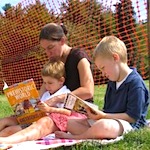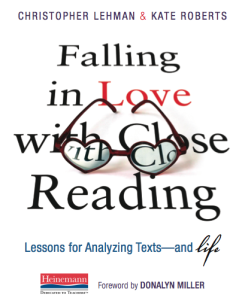How I Fell in Love with Close Reading
Falling in Love with Close Reading: Lessons for Analyzing Texts—and Life
Christopher Lehman and Kate Roberts
(Heinemann, 2013 – Learn more)

I ♥ Falling in Love with Close Reading by Chris Lehman and Kate Roberts. I think you will, too.
Last summer, I didn’t even want to hear about close reading any more. Every session at every literacy event I had been to for the past year claimed to offer tips and tricks for this centerpiece of the Common Core.
I had heard about the four corners of the text, but worried that the reader was lost in the process. I had seen graphic organizers, and worksheets, and the magic questions, but they all seemed to be more about the book than the reading. It didn’t quite fit my philosophy of teaching reading.
I had close reading fatigue.

So when I first heard that Lehman was going to be releasing a book on close reading, I didn’t immediately dismiss it. A colleague directed me to Lehman’s blog-a-thon on close reading, and I was hooked as I read the insights shared by Lehman and Roberts. As the release date approached, I pre-ordered my copy.
Several things I love about this book
I love that the authors see close reading as much a tool for our lives as a tool for books. Roberts described in one of her blog posts how love brings us in close. She explained how well we know the ones we love the most, because we’ve taken time to observe them closely and repeatedly, and even tiny details reveal nuance.
Falling in Love with Close Reading builds on this idea. The routines it establishes are simple, yet they help us as readers to grow sophisticated ideas from the patterns we notice in the details of a text.
Other experts who present close reading have shared rich-sounding discussions over daunting texts, but you have to wonder whether any students could continue that species of close reading without the teacher at their side asking the questions. This book presents a view of close reading instruction that aims first and foremost for independence.
By applying a variety of lenses to our reading, we can read closely for a variety of purposes in a variety of texts. Once students know the lenses, they can take them to any text they encounter, whether that text is a song, a novel, an editorial, or a political ad. Our students will be able to read without us.
The authors present clear examples of each lens as it would look when applied to literary and informational texts. They describe this close reading work as it applies to complex, yet highly engaging multimedia “texts.” Between these covers I find the resources I would need for teaching new media as well as the classics.
A book that will stretch to grades 3-4
While the book is intended to describe close reading for students in grades 5-8, I am finding that with some thought about text selection and consideration about language friendly to younger students, these routines are simple enough to work with grades 3 and 4 as well. (Note: Lehman and Roberts are working on a version for the lower grades to be released in the future.)
The good news is that I have found a resource that is consistent with my beliefs about reading instruction. The better news is that this work has been field tested with many, many students. The best news is that I’m learning about the invisible processes I use as a reader so that I can reveal them to students for whom they are not automatic.
Because of Falling in Love with Close Reading, I have the tools to teach students and to support teachers in the practice of close reading. It is something I can teach them to do for themselves instead of something that will be done to them.
Read another MiddleWeb review of this book
As an elementary reading consultant and coach, Katie Gordon splits her time between “building the reading capacity of my students and the teaching capacity of my colleagues.” She comes to coaching from ten years in middle and high school classrooms, during which time “I struggled to find the answers for the challenges my own students were facing.” She lives in Connecticut.

































